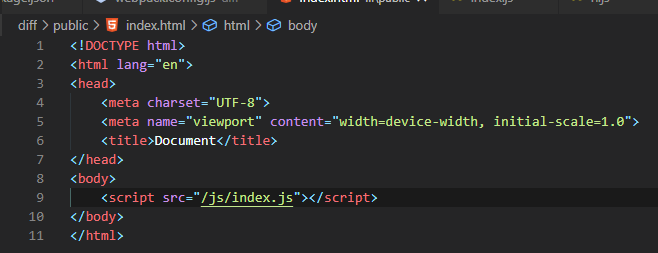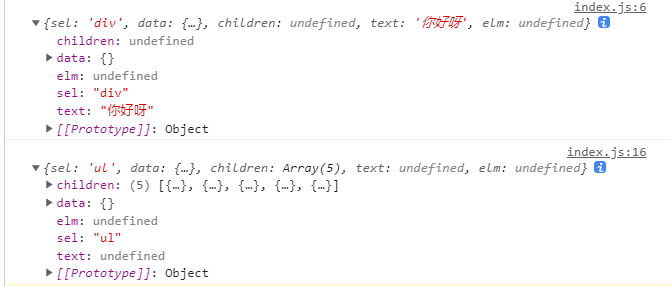Environment Setup
- Create a folder, go to the folder directory, and use NPM init-y to generate the package.json file.
Download webpack, webpack-cli, webpack-dev-server, with particular attention to the various versions of webpack.
Download the corresponding version
cnpm i webpack@5 webpack-cli@3 webpack-dev-server@3 -S
- Create webpack.config.js file
module.exports = {
entry: {
index: './src/index.js'
},
output: {
path: __dirname + '/public',
filename: './js/[name].js'
},
devServer: {
contentBase: './public',
inline: true
}
}
- Create a file based on the contents of the webpack.config.js file
File directory after creation

- Introducing a js file into the index.html file

- Run the program
Run commands need to be added to the package.json file
{
"name": "diff",
"version": "1.0.0",
"description": "",
"main": "index.js",
"scripts": {
"dev": "webpack-dev-server"
},
"keywords": [],
"author": "",
"license": "ISC",
"dependencies": {
"webpack": "^5.52.1",
"webpack-cli": "^3.3.12",
"webpack-dev-server": "^3.11.2"
}
}
- Run the program
npm run dev
Create h Function
- Create a new folder dom under src, create a new file h.js
import vnode from './vnode'
export default function(sel, data, params) {
// console.log(sel, data, params)
// Without child elements
if(typeof params === 'string') {
return vnode(sel, data, undefined, params, undefined)
} else if(Array.isArray(params)) { // With child elements
let children = []
for(let item of params) {
children.push(item)
}
return vnode(sel, data, children, undefined, undefined)
}
}
- Create a new vnode.js under the dom folder, which converts a real dom into a virtual dom
export default function(sel, data, children, text, elm) {
/**
* sel: Virtual dom
* data: key
* children: Child Elements
* text: Text Content
* elm: True dom
*/
return {
sel,
data,
children,
text,
elm
}
}
- Create virtual dom in index.js
import h from './dom/h'
let vnode1 = h("div", {}, "How do you do");
console.log(vnode1)
let vnode2 = h("ul", {}, [
h("li", {}, "a"),
h("li", {}, "b"),
h("li", {}, "c"),
h("li", {}, "d"),
h("li", {}, "e"),
]);
console.log(vnode2)
- Run Results

Turn a real dom into a virtual dom and compare the old and new virtual nodes
- If the old and new nodes are not the same node name, then the old node is deleted and the new node is inserted violently for a long time.
1. Write a new div under index.html
<div id="container">This is container</div>
2. Get the div real dom node under index.html under index.js
// Get the real dom node
const container = document.getElementById('container')
3. Create a virtual node to patch the virtual node onto the real dom
// Virtual Node
let vnode1 = h("h1", {}, "How do you do");
// console.log(vnode1)
let vnode2 = h("ul", {}, [
h("li", {}, "a"),
h("li", {}, "b"),
h("li", {}, "c"),
h("li", {}, "d"),
h("li", {}, "e"),
]);
patch(container, vnode1)
4. Create a new patch.js function to convert a real DOM into a virtual dom, and then compare the new virtual DOM with the old one.
import vnode from './vnode'
import createElement from './createElement'
/**
* @param {*} oldVnode Old Virtual Node
* @param {*} newVnode New Virtual Node
*/
export default function (oldVnode, newVnode) {
// If oldVnode has no sel, it is a non-virtual node
if (oldVnode.sel === undefined) {
// console.log(oldVnode.tagName.toLowerCase())
oldVnode = vnode(
oldVnode.tagName.toLowerCase(), //Virtual Node Name
{},
[],
undefined,
oldVnode // Real dom elements
)
}
// console.log(oldVnode)
// Start judging old and new virtual nodes
if (oldVnode.sel !== newVnode.sel) { // If the old and new nodes are not the same node name, then the old node is deleted and the new node is inserted violently for a long time.
// Create a new virtual node as a real dom node
let newVnodeElm = createElement(newVnode) // It's a good idea to write a function that creates a real dom for recursive calls
// console.log(newVnodeElm)
let oldVnodeElm = oldVnode.elm
if(newVnodeElm) {
oldVnodeElm.parentNode.insertBefore(newVnodeElm, oldVnodeElm)
}
oldVnodeElm.parentNode.removeChild(oldVnodeElm)
} else { // Is the same node, logic becomes complex
}
}
5. Create a new createElement.js file to convert virtual nodes into real nodes and mount them on the real dom
export default function createElement (vnode) {
let domNode = document.createElement(vnode.sel)
// Determine if there are children
if(vnode.children === undefined) {
domNode.innerText = vnode.text
}else if(Array.isArray(vnode.children)) {
for(let child of vnode.children) {
let childDom = createElement(child)
domNode.appendChild(childDom)
}
}
vnode.elm = domNode
return domNode
}
- If the nodes are the same, there are several cases
- (1) The new node has no children and is replaced directly
- (2) The new node has children, the old node has children, and the diff algorithm core
- (3) New node has children, old node does not, directly create element add
Create a new patchVnode.js file to determine if the old and new virtual nodes are the same
import createElement from './createElement'
export default function(oldVnode, newVnode) {
// Determine if a new node has child elements
if(newVnode.children === undefined) { // No child elements
if(newVnode.text !== oldVnode.text) {
oldVnode.elm.innerText = newVnode.text
}
} else { // Has child elements
// Determine if the old node has child elements
if(oldVnode.children && oldVnode.children.length > 0) { // Old node has child elements, which is more complex
} else { // Old node has no child elements
oldVnode.elm.innerHTML = '' // Delete the contents of old nodes
for(let child of newVnode.children) {
let childDom = createElement(child)
oldVnode.elm.appendChild(childDom)
}
console.log(oldVnode.elm)
}
}
}
patch.js file
import vnode from './vnode'
import createElement from './createElement'
import patchVnode from './patchVnode'
/**
* @param {*} oldVnode Old Virtual Node
* @param {*} newVnode New Virtual Node
*/
export default function (oldVnode, newVnode) {
// If oldVnode has no sel, it is a non-virtual node
if (oldVnode.sel === undefined) {
// console.log(oldVnode.tagName.toLowerCase())
oldVnode = vnode(
oldVnode.tagName.toLowerCase(), //Virtual Node Name
{},
[],
undefined,
oldVnode // Real dom elements
)
}
// console.log(oldVnode)
// Start judging old and new virtual nodes
if (oldVnode.sel !== newVnode.sel) { // If the old and new nodes are not the same node name, then the old node is deleted and the new node is inserted violently for a long time.
// Create a new virtual node as a real dom node
let newVnodeElm = createElement(newVnode) // It's a good idea to write a function that creates a real dom for recursive calls
// console.log(newVnodeElm)
let oldVnodeElm = oldVnode.elm
if(newVnodeElm) {
oldVnodeElm.parentNode.insertBefore(newVnodeElm, oldVnodeElm)
}
oldVnodeElm.parentNode.removeChild(oldVnodeElm)
} else { // Is the same node, logic becomes complex
patchVnode(oldVnode, newVnode)
}
}
index.js file
import h from './dom/h'
import patch from './dom/patch'
// Virtual Node
// let vnode1 = h("div", {}, "hello");
let vnode1 = h("div", {}, [
h("span", {}, "a"),
h("span", {}, "b"),
h("span", {}, "c"),
h("span", {}, "d"),
h("span", {}, "e"),
]);
// Get the real dom node
const container = document.getElementById('container')
patch(container, vnode1)
diff algorithm core
- 1. Old and New
Match: Old Front Pointer++, New Front Pointer++. - 2. Old and New
Match: Old Post Pointer -, New Post Pointer -. - 3. Before and after the old
Match: Old Front Pointer++, New Back Pointer- - 4. After and Before the Old
Match: Old Back Pointer - New Front Pointer+. - 5. None of the above meets the criteria=== to find
Find: New pointer++, renders the element pointed to by the new pointer to the page, and assigns undefined to the corresponding element found in the old node - 6. Create or delete
Create a new updateChildren.js to handle five cases in the diff algorithm
import patchVnode from './patchVnode'
import createElement from './createElement'
// Determine whether two virtual nodes are the same node
function sameVnode(vnode1, vnode2) {
return vnode1.key === vnode2.key
}
/**
*
* @param {*} parentElm Old parent node
* @param {*} oldCh Old Child Node
* @param {*} newCh New Child Node
*/
export default function(parentElm, oldCh, newCh) {
// console.log(parentElm, oldCh, newCh)
let oldStartIdx = 0 // Old Front Pointer
let oldEndIdx = oldCh.length - 1 // Old back pointer
let newStartIdx = 0 // New Front Pointer
let newEndIdx = newCh.length - 1 // New Post Pointer
let oldStartVnode = oldCh[0] // Old Former Virtual Node
let oldEndVnode = oldCh[oldEndIdx] // Old Post Virtual Node
let newStartVnode = newCh[0] // New Front Virtual Node
let newEndVnode = newCh[newEndIdx] // New Post Virtual Node
while(oldStartIdx <= oldEndIdx && newStartIdx <= newEndIdx) {
if(oldStartVnode === undefined) {
oldStartVnode = [++oldStartIdx]
}
if(oldEndVnode === undefined) {
oldEndVnode = [--oldEndIdx]
}else if(sameVnode(oldStartVnode, newStartVnode)) {
// Old and New
console.log(1)
patchVnode(oldStartVnode, newStartVnode)
if(newStartVnode) {
newStartVnode.elm = oldStartVnode?.elm
}
oldStartVnode = oldCh[++oldStartIdx]
newStartVnode = newCh[++newStartIdx]
}else if(sameVnode(oldEndVnode, newEndVnode)) {
// Old and New
console.log(2)
patchVnode(oldEndVnode, newEndVnode)
if(oldEndVnode) {
newEndVnode.elm = oldEndVnode?.elm
}
oldEndVnode = oldCh[--oldEndIdx]
newEndVnode = newCh[--newEndIdx]
}else if(sameVnode(oldStartVnode, newEndVnode)) {
// Before and after
console.log(3)
patchVnode(oldStartVnode, newEndVnode)
if(oldStartVnode) {
newEndVnode.elm = oldStartVnode?.elm
}
// Move the previously specified node behind the old pointed node
parentElm.insertBefore( oldStartVnode.elm, oldEndVnode.elm.nextSibling )
oldStartVnode = oldCh[++oldStartIdx]
newEndVnode = newCh[--newEndIdx]
} else if(sameVnode(oldEndVnode, newStartVnode)) {
// Old behind and new before
console.log(4)
patchVnode(oldEndVnode, newStartVnode)
if(oldEndVnode) {
newStartVnode.elm = oldEndVnode?.elm
}
// Moves the old specified node to the front of the old pointed node
parentElm.insertBefore( oldEndVnode.elm, oldStartVnode.elm )
oldEndVnode = oldCh[--oldEndIdx]
newStartVnode = newCh[++newStartIdx]
} else {
// None of the above satisfies the criteria=== search
console.log(5)
// Create an object storage virtual node
let keyMap = {}
for(let i = oldStartIdx;i <= oldEndIdx;i++) {
const key = oldCh[i]?.key
if(key) {
keyMap[key] = i
}
}
// console.log(keyMap)
// Finding the Node to which the Front Node Points in the Old Node
let indxInOld = keyMap[newStartVnode.key]
if(indxInOld) { // Can find
const elmMove = oldCh[indxInOld]
patchVnode(elmMove, newStartVnode)
// Processed node, set to undefined in the array of old virtual nodes
oldCh[indxInOld] = undefined
parentElm.insertBefore(elmMove.elm, oldStartVnode.elm)
}else { // Can't find
// Description is a new node and needs to be recreated
parentElm.insertBefore(createElement(newStartVnode), oldStartVnode.elm)
}
// New Node Pointer+1
newStartVnode = newCh[++newStartIdx]
}
}
}
Reference updateChildren method in patchVnode.js
import createElement from './createElement'
import updateChildren from './updateChildren'
export default function patchVnode (oldVnode, newVnode) {
// console.log(oldVnode)
// Determine if a new node has child elements
if (newVnode.children === undefined) { // No child elements
if (newVnode.text !== oldVnode.text) {
oldVnode.elm.innerText = newVnode.text
}
} else { // Has child elements
// Determine if the old node has child elements
if (oldVnode.children && oldVnode.children.length > 0) { // Old node has child elements, which is more complex
updateChildren(oldVnode.elm, oldVnode.children, newVnode.children)
// console.log(oldVnode.elm, oldVnode.children, newVnode.children)
} else { // Old node has no child elements
oldVnode.elm.innerHTML = '' // Delete the contents of old nodes
for (let child of newVnode.children) {
let childDom = createElement(child)
oldVnode.elm.appendChild(childDom)
}
// console.log(oldVnode.elm)
}
}
}
- Create or delete nodes
Add the following code to updateChild.js
// There are only two cases to end while (add and delete)
// 1,oldStartIdx > oldEndIdx
// 2,newStartIdx > newEndIdx
if(oldStartIdx > oldEndIdx) {
const before = newCh[newEndIdx + 1] ? newCh[newEndIdx + 1].elm : null
for(let i = newStartIdx;i <= newEndIdx;i++) {
parentElm.insertBefore((createElement(newCh[i])), before)
}
} else { // Enter Delete Operation
for(let i = oldStartIdx;i <= oldEndIdx;i++) {
// console.log(oldCh[i])
parentElm.removeChild(oldCh[i].elm)
}
}
Reference
https://www.bilibili.com/video/BV1K64y1s7ot?p=9&spm_id_from=pageDriver
All Code
gitee address https://gitee.com/jjm1/diff